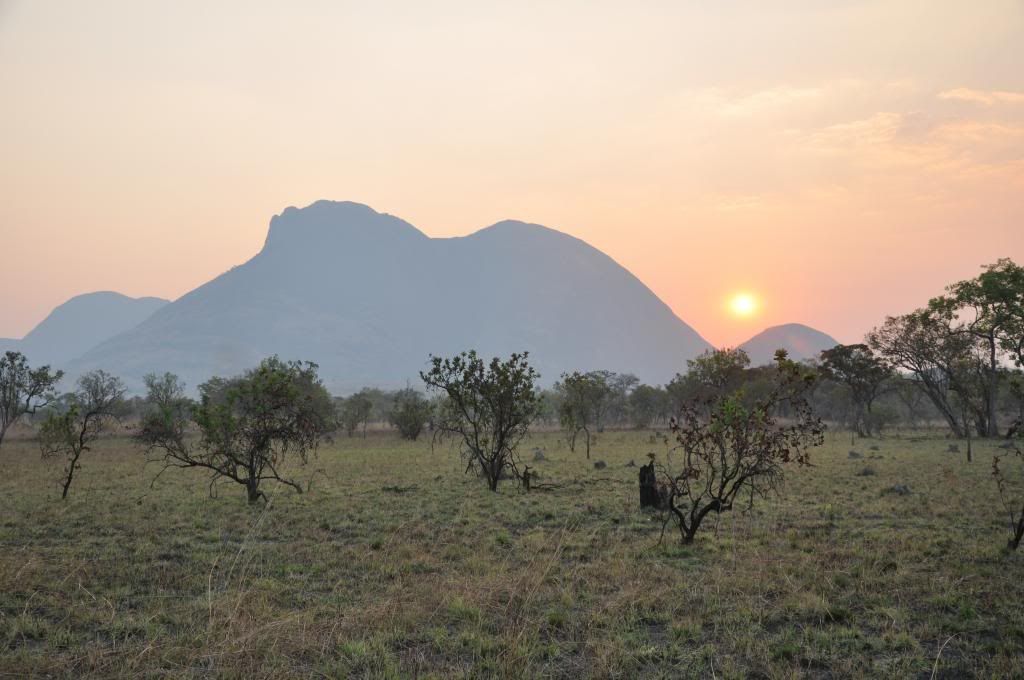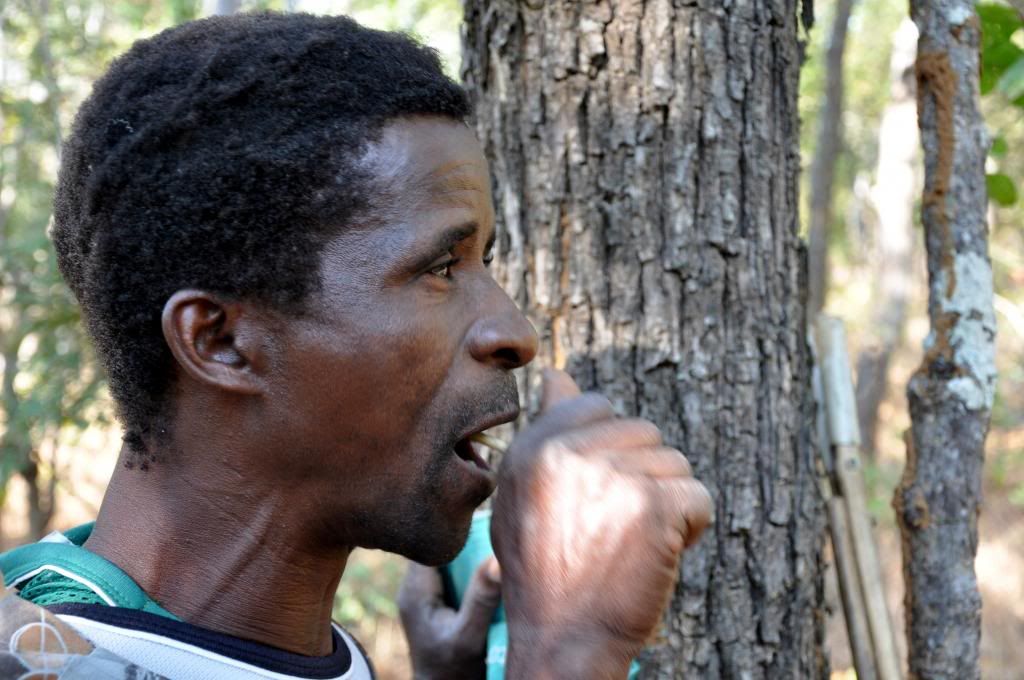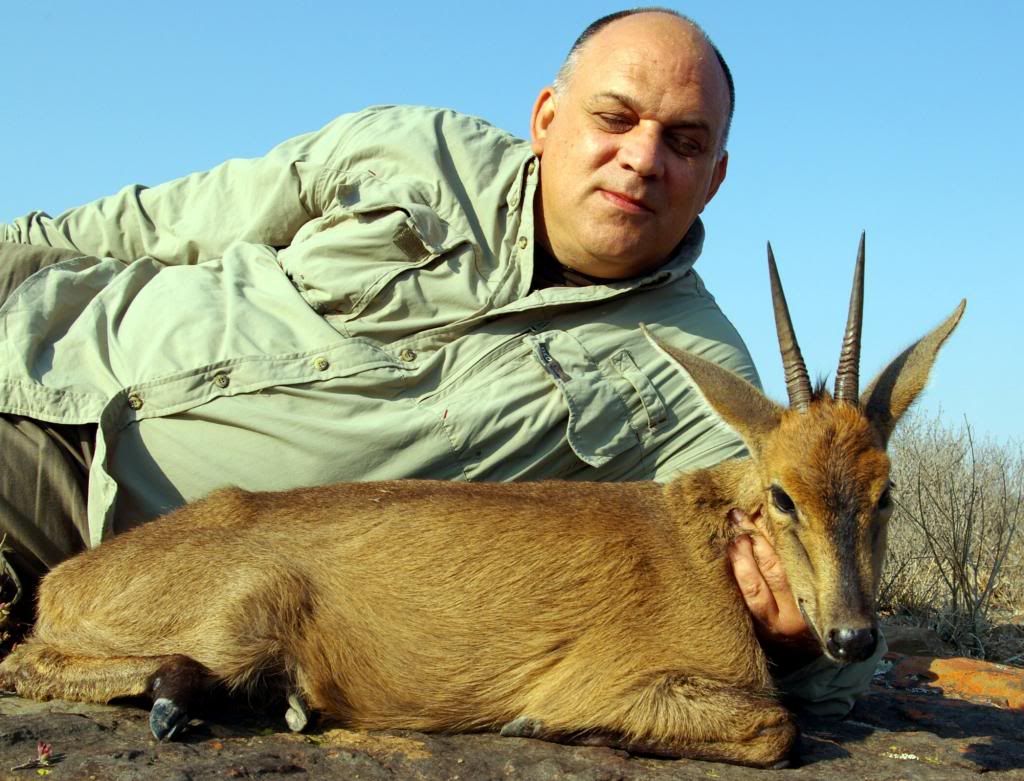

 The Accurate Reloading Forums
The Accurate Reloading Forums  THE ACCURATE RELOADING.COM FORUMS
THE ACCURATE RELOADING.COM FORUMS  Hunting
Hunting  African Big Game Hunting
African Big Game Hunting  Duiker Yarns - Story by Kevin Thomas
Duiker Yarns - Story by Kevin ThomasGo  | New  | Find  | Notify  | Tools  | Reply  |  |
| One of Us |
Duiker Yarns Kevin Thomas© If I cast my mind back far enough, to when I was about 7 years old, I still have clear recall of a dazzling light, a reflective eye in the dark, and then a sudden shot which immediately extinguished the shining eye. John Tweedie our dairy stockman on the government farm near the Mozambique border in Rhodesia’s (Zimbabwe’s) Eastern Highlands was the cause of the shot. He was standing on the back, and using the cab of our old 1950 Series 1 Land Rover as a shooting rest. I was standing between him and the person holding the spotlight – my Dad was behind the steering wheel. The calibre used was our trusty old .22 Hornet, and we were out looking for ‘venison’ – a common reedbuck had been high on our want list, or a bushbuck ram – however, the luckless owner of the reflective eye was the ubiquitous common bush or grey duiker – a male. What makes this somewhat uncomfortable and far off memory stick though, was the plaintive bleating and screaming the little antelope made when John the stockman was cutting its throat to bleed it. His one and only shot had not been clean, a messy ending to an equally unethical and illegal way of hunting. However, when venison was needed during the early 1950s in Rhodesia, reaching for the spotlight after a hard day’s work was an easy option – sport hunting amongst many farmers’, unless it was game birds, unheard of. Fifty-six years on, whenever I see or think of a common duiker, that image combined with the sound effects immediately pops up in my mind, and so fresh has it remained, if I focus hard enough, I can almost smell the khaki bos (bush), flattened and bruised beneath the vehicle wheels, on the fringe of the maize field. Over the previous decades, I too have accounted for a fair number of common duiker, although we tended to look upon them as a handy little antelope to hone our hunting skills on as we ventured our way through boyhood. We were also taught at an early age to avoid shooting duiker around any form of human habitation because of their scavenging habit, legend has it that they were not averse to eating human waste around tribal kraals (collective dwellings). Although I’ve never witnessed this behaviour, common duiker most certainly do have a varied diet, and there are scientific records of stomach contents containing unusual items such as guinea fowl chicks, ducklings, turkey chicks, striped-mice, and a lizard. Common duiker are widespread throughout sub-Saharan Africa with bush being an essential habitat requirement for not only shelter and shade, but also the provision of their main food; leaves, twigs, flowers and fruit. Normally solitary, they can be found in pairs when a female is in oestrus, and females with a single young normally move together. Unless a client is endeavouring to collect all of our ‘little’ antelope, the common duiker is invariably also considered one of those opportunistic safari ‘filler’ species. It isn’t too difficult to find in areas where they aren’t subject to a lot of hunting pressure, where during an early morning or late evening you only need sit or walk quietly through the brush thickets frequented by duiker, and sooner or later one will appear. At times they can also be called in using a commercial brand handheld predator caller, or a rolled and flattened mopane leaf, or as is used to good effect by Makua tribal hunters’ in Mozambique’s Niassa Province, a modified dry stalk of elephant grass. All of which when blown into, closely mimic the distress bleating of a duiker, and if done correctly bring them in fast and determinedly (not to mention a few other species like jackal!). A few years back I was a guest on Swiss businessman Urs Wettstein’s Niassa concession in northern Mozambique and despite a colleague of his, Werner Huber and me; having tried it countless times with a Makua tracker we never even saw a common duiker! – Maybe because it’s worked too well – resulting in diminished duiker numbers on that particular forestry concession. Both male and female common duikers have a tuft of dark brown or black hair sticking up in the middle of the head, and even in the hornless females, if in poor light this can be mistaken for a single horn. Obviously lighter calibres are the way to go with duiker; however a solid bullet in the heavier calibres will also result in a kill not being blown apart, as would happen with a heavier calibre soft-nose. If trying to subdue a wounded common duiker, be aware that the species is capable of frantic and violent kicking and struggling, and the sharp horns and hooves can inflict injury. The only other duiker which I have had any exposure to, is the tiny forest dwelling blue duiker, with my first introductions to this species being by way of finding hidden skins and skulls in poacher’s huts during 1969/70 in eastern Rhodesia’s Honde Valley. The tribal poachers of that era hung waist high hand woven nets of bark, between the trees beneath the forest canopy, blue duiker were then driven into these and stabbed with spears, or dispatched with a traditional demo (axe) during organised drives using beaters and dogs. Although the late Ollie Coltman and I arrested many poachers, shot countless dogs, confiscated roll upon roll of nets, and spears, I’m sure that now 43 years on, deforestation more than poaching has probably lead to the demise of the Honde Valley’s remaining blue duiker population. In West Africa’s forests the Baka pygmy hunters’ very effectively call in blue duiker, again using distress mimicry, and standing strung out, frozen statue like with spear arm raised, they wait for an unwary blue duiker to come in to the stress call, it is then quickly dispatched with a sharp pointed Baka spear. Even this way of sustainable tribal hunting is now threatened as never before by deforestation, and the insidious bush meat trade. Blue duiker follow established trails through their forest environment and fall easy prey to snares. Here in South Africa’s Eastern Cape, we’re still blessed with fantastic sustainable and well-regulated trophy hunting for blue duiker. Our dense coastal dune forests and forested thickets slightly inland from the coast, afford natural refuge for this delightful scrub-hare sized 4kg antelope. Unlike the common duiker though, both blue duiker sexes carry horns, and both are deemed ‘trophy’ although every effort is made to shoot a male – not always easy. My mental image of blue duiker hunting has always been one of the hunters momentarily entering into an atmospheric environment of subdued green light, green moss covered trees, moist green lichen covered deadfalls, green brackens and grasses, green lianas etc. A damp humid world where you walk bent at the waist, get hooked up on thorns, slither and slide on steep inclines, and constantly grab at handy hanging vines to steady yourself – seemingly a world away from the adjacent sunlit grassed and gently rolling hills where you left the hunting rig. Blue duikers share this shadowy world with two other denizens of the forest, also worthy and challenging trophies - the wily bushbuck and bushpig. Sitting or standing quietly, watching over a well defined blue duiker trail or dung midden, or an open glade within the forest, whilst well hidden by tree trunks and green forest foliage, the hunter may hear the hoarse ‘kow-kow-kow’ call of the stunningly beautiful Knysna turaco, or catch a brief glimpse of one as it branch runs through the canopy above, although a hunter’s just as likely to hear the rhythmic crash of the Indian Ocean surf beyond the dune forests. Once seen, shooting a blue duiker is normally a quick affair, and particularly so when driven, because they seldom linger, darting across tracks and cut-lines, or jinking and diving along their well used forest trails, low to the ground, a blue/grey blur. For this reason in the Eastern Cape a 12ga loaded with AAA or No 1 shot is the weapon of choice, and the shot will invariably be instinctive, with the gun held to the shoulder well before the duiker’s arrival. Due to its diminutive form, in the immediate aftermath of the gunning exercise, if the blue duiker didn’t fall to the shot, a thorough search for blood sign must be made of the surrounding area and dense undergrowth, or the hunter may lose a truly noble forest dwelling trophy.  Typical common duiker habitat in northern Mozambique’s Niassa Province.  Che Che Mountain sunset, Niassa, Mozambique.  Swiss hunter Werner Huber and Makua tracker Albina walk through the bush in Mozambique’s Niassa province in quest of a common duiker.  Makua tracker Albina uses a modified grass stalk to call in common duiker while hunting in Mozambique’s Niassa province.  Client Antonio Molina with his common duiker trophy – photo credit PH Keith Gradwell.  Leonora Gilbert from British Colombia with her common duiker.  Typical Eastern Cape blue duiker habitat.  Landowner Adrian Ford and client Bill Haslett enter the dune forest in quest of a blue duiker.  … get hooked up on thorns, slither and slide on steep inclines …  … or standing quietly, watching over a well-defined blue duiker trail …  After Bill Haslett’s shot Adrian Ford carefully checks the trail for blood sign.  Bill Haslett’s excellent blue duiker.  PH Glen Elliot with client Larry Bernhardt and a fine blue duiker – photo credit PH Glen Elliot.  Irrespective of what one is hunting in northern Mozambique, the magnificent inselbergs invariably form a stunning backdrop. Kevin Thomas Safaris Zimbabwe - Eastern Cape E-mail: ktsenquiries@mweb.co.za Website: www.ktsafaris.co.za | ||
|
| One of Us |
Thanks for the great story and pics Kevin!   | |||
|
| One of Us |
Great story, thanks. I hope to collect the southern diker family in my life time. | |||
|
| One of Us |
That's real cool. Takes me back to the early 80's and shooting Muntjack in Tea Plantations in India with a shotgun. "When the wind stops....start rowing. When the wind starts, get the sail up quick." | |||
|
| One of Us |
A quite attractive little animal. Why do all you guys feel a need to laydown, or hide way back behind your game to make them look much larger? Sure distorts the pictures imo. No way of judging actual size that way. Stand beside them, or if small enough hold them in your hands would be much better. Thank you for sharing the great pictures though. George "Gun Control is NOT about Guns' "It's about Control!!" Join the NRA today!" LM: NRA, DAV, George L. Dwight | |||
|
| One of Us |
I don't know. That's what the cameraman told me to do! | |||
|
| One of Us |
Go shoot one and find a good way to "hold it" without it getting messy or looking like a rag doll. If you stand beside them the only detail you see is of the hunter, zero of the animal. Trust me, we went through this last week. Its hard to get a trophy photo of a tiny animal. | |||
|
| Powered by Social Strata |
| Please Wait. Your request is being processed... |
|
 The Accurate Reloading Forums
The Accurate Reloading Forums  THE ACCURATE RELOADING.COM FORUMS
THE ACCURATE RELOADING.COM FORUMS  Hunting
Hunting  African Big Game Hunting
African Big Game Hunting  Duiker Yarns - Story by Kevin Thomas
Duiker Yarns - Story by Kevin Thomas

Visit our on-line store for AR Memorabilia

